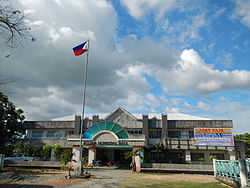Aliaga, Nueva Ecija
Aliaga | |
|---|---|
| Municipality of Aliaga | |
 Municipal Hall | |
 Map of Nueva Ecija with Aliaga highlighted | |
Location within the Philippines | |
| Coordinates: 15°30′13″N 120°50′42″E / 15.5036°N 120.845°E | |
| Country | |
| Region | Central Luzon |
| Province | Nueva Ecija |
| District | 1st District |
| Barangays | 26 (see Barangays) |
| Government | |
| • Type | Sangguniang Bayan |
| • Mayor | Elizabeth Roman Vargas |
| • Electorate | 49,634 voters (2022) |
| Area | |
| • Total | 90.04 km2 (34.76 sq mi) |
| Population (2020 census)[3] | |
| • Total | 70,363 |
| • Density | 780/km2 (2,000/sq mi) |
| Time zone | UTC+8 (PST) |
| ZIP code | 3111 |
| PSGC | |
| IDD : area code | +63 (0)44 |
| Income class | 2nd municipal income class |
| Revenue (₱) | ₱ 190.7 million (2020) |
| Native languages | Tagalog Ilocano |
| Website | www |
Aliaga, officially the Municipality of Aliaga, is a 2nd class municipality in the province of Nueva Ecija, Philippines. According to the 2020 census, it has a population of 70,363 people.[3]
Formerly it was called Pulung Bibit and Maynilang Munti (Little Manila). The First mayor is Aneceto Pere.
It has a comparatively cool and healthful climate, and is situated about midway between the Pampanga Grande and the Pampanga Chico rivers, in a large and fertile valley. Historically, the principal products were mostly agricultural such as rice, tomato, eggplant, squash.[4]
Tagalog and Ilocano are the most important and the major languages of the municipality.
Barangays
Aliaga is politically subdivided into 26 barangays.
- Betes
- Bibiclat
- Bucot
- La Purisima
- Magsaysay
- Macabucod
- Pantoc
- Poblacion Centro
- Poblacion East I
- Poblacion East II
- Poblacion West III
- Poblacion West IV
- San Carlos
- San Emiliano
- San Eustacio
- San Felipe Bata
- San Felipe Matanda
- San Juan
- San Pablo Bata
- San Pablo Matanda
- Santa Monica
- Santiago
- Santo Rosario
- Santo Tomas
- Sunson
- Umangan
Demographics
| Year | Pop. | ±% p.a. |
|---|---|---|
| 1903 | 11,950 | — |
| 1918 | 12,703 | +0.41% |
| 1939 | 15,149 | +0.84% |
| 1948 | 12,594 | −2.03% |
| 1960 | 18,759 | +3.38% |
| 1970 | 24,449 | +2.68% |
| 1975 | 28,290 | +2.97% |
| 1980 | 32,349 | +2.72% |
| 1990 | 40,425 | +2.25% |
| 1995 | 45,815 | +2.37% |
| 2000 | 50,004 | +1.89% |
| 2007 | 61,270 | +2.84% |
| 2010 | 57,805 | −2.10% |
| 2015 | 63,543 | +1.82% |
| Source: Philippine Statistics Authority[5][6][7][8] | ||
Art and Culture
The Taong Putik Festival is an annual feast held every 24 June. It is a religious festival celebrated by the locals and devotees to pay homage to San Juan Bautista on his feast day by wearing costumes patterned to his attire. The taong putik (Filipino term) soak themselves in mud and cover their body with dried banana leaves and visit houses or ask people for alms in a form of candle or money to buy candles which they offer for Saint John the Baptist to celebrate his feast day.
References
- ^ Municipality of Aliaga | (DILG)
- ^ "Province: Nueva Ecija". PSGC Interactive. Quezon City, Philippines: Philippine Statistics Authority. Retrieved 12 November 2016.
- ^ a b Census of Population (2020). "Region III (Central Luzon)". Total Population by Province, City, Municipality and Barangay. Philippine Statistics Authority. Retrieved 8 July 2021.
- ^ One or more of the preceding sentences incorporates text from a publication now in the public domain: Chisholm, Hugh, ed. (1911). "Aliaga". Encyclopædia Britannica. Vol. 1 (11th ed.). Cambridge University Press. p. 661.
- ^ Census of Population (2015). "Region III (Central Luzon)". Total Population by Province, City, Municipality and Barangay. Philippine Statistics Authority. Retrieved 20 June 2016.
- ^ Census of Population and Housing (2010). "Region III (Central Luzon)" (PDF). Total Population by Province, City, Municipality and Barangay. National Statistics Office. Retrieved 29 June 2016.
- ^ Censuses of Population (1903–2007). "Region III (Central Luzon)". Table 1. Population Enumerated in Various Censuses by Province/Highly Urbanized City: 1903 to 2007. National Statistics Office.
{{cite encyclopedia}}: CS1 maint: numeric names: authors list (link) - ^ "Province of Nueva Ecija". Municipality Population Data. Local Water Utilities Administration Research Division. Retrieved 17 December 2016.
External links
- Pasyalan Nueva Ecija
- Philippine Standard Geographic Code
- Philippine Census Information
- Local Governance Performance Management System


